
A germ cell is any biological cell that gives rise to the gametes of an organism that reproduces sexually. In many animals, the germ cells originate in the primitive streak and migrate via the gut of an embryo to the developing gonads. There, they undergo meiosis, followed by cellular differentiation into mature gametes, either eggs or sperm. Unlike animals, plants do not have germ cells designated in early development. Instead, germ cells can arise from somatic cells in the adult, such as the floral meristem of flowering plants.

The Catalogue of Principal Galaxies (PGC) is an astronomical catalog published in 1989 that lists B1950 and J2000 equatorial coordinates and cross-identifications for 73,197 galaxies. It is based on the Lyon-Meudon Extragalactic Database (LEDA), which was originally started in 1983. 40,932 coordinates (56%) have standard deviations smaller than 10″. A total of 131,601 names from the 38 most common sources are listed. Available mean data for each object are given:
David Dunlap Observatory Catalogue, known as the DDO or A Catalogue of Dwarf Galaxies, is a catalogue of dwarf galaxies that was compiled by Sidney van den Bergh and published by the David Dunlap Observatory in 1959.
The Pennsylvania State Game Lands (SGL) are lands managed by the Pennsylvania Game Commission (PGC) for hunting, trapping, and fishing. These lands, often not usable for farming or development, are donated to the PGC or purchased by the PGC with hunting license monies.

Peroxisome proliferator-activated receptor gamma coactivator 1-alpha (PGC-1α) is a protein that in humans is encoded by the PPARGC1A gene. PPARGC1A is also known as human accelerated region 20 (HAR20). It may, therefore, have played a key role in differentiating humans from apes.

Peroxisome proliferator-activated receptor gamma coactivator 1-beta is a protein that in humans is encoded by the PPARGC1B gene.

The Lyon-Meudon Extragalactic Database (LEDA) was a database of galaxies, created in 1983 at the Lyon Observatory. Each galaxy had a number assigned to it, which is now known as its PGC number. The Principal Galaxies Catalogue (PGC), published in 1989, was based on the Lyon-Meudon Extragalactic Database and contained cross-identifications for it. LEDA was eventually merged with Hypercat to become HyperLEDA in 2000, itself also known as PGC2003. LEDA originally contained information on more than 60 parameters for about 100,000 galaxies, and now contains information on over 3 million celestial objects, of which about 1.5 million are galaxies. The database allows astronomers around the world access to its information.
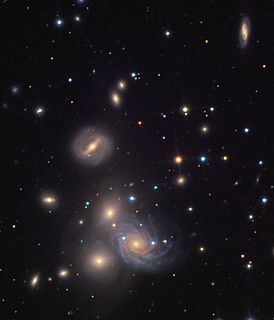
NGC 67 is an elliptical galaxy located in the constellation Andromeda that was discovered on October 7, 1855 by R. J. Mitchell, who described it as "extremely faint, very small, round". The galaxy belongs to the NGC 68 group, which also contains the galaxies NGC 68, NGC 69, NGC 70, NGC 71, NGC 72, and possibly NGC 74.

NGC 6221 is a barred spiral galaxy located in the constellation Ara. In de Vaucouleurs' galaxy morphological classification scheme, it is classified as SB(s)bc and was discovered by British astronomer John Herschel on 3 May 1835. NGC 6221 is located at about 69 million light years from Earth.
NGC 6215 is a spiral galaxy located in the constellation Ara. It is designated as SA(s)c in the galaxy morphological classification scheme. It was discovered by astronomer John Herschel on 9 July 1836.
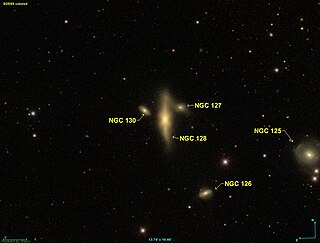
NGC 125 is a lenticular galaxy located in the constellation Pisces. It is designated as subclass Sa Ring in the galaxy morphological classification scheme. It lies approximately 235 million light-years away.
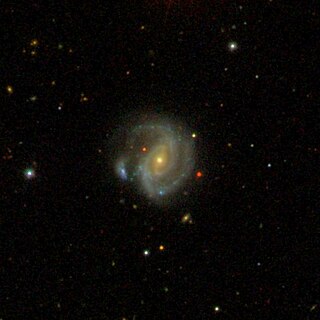
NGC 341 is a spiral galaxy in the constellation Cetus. It was discovered on October 21, 1881 by Édouard Stephan. It was described by Dreyer as "faint, pretty large, round, a little brighter middle, mottled but not resolved." It has a companion galaxy, PGC 3627, which is sometimes called NGC 341B. For this, reason, it has been included in Halton Arp's Atlas of Peculiar Galaxies.

ESO 198-13 is a ring galaxy with multiple ring-like structures located about 240 million light-years away in the constellation Eridanus.
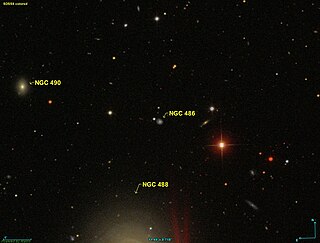
NGC 486, also occasionally referred to as LEDA 1281966 or GC 275, is a spiral galaxy in the constellation Pisces. NGC 486 was discovered on December 6, 1850 by Irish engineer Bindon Blood Stoney.

NGC 6040 is a spiral galaxy located about 550 million light-years away in the constellation Hercules. NGC 6040 was discovered by astronomer Édouard Stephan on June 27, 1870. NGC 6040 is interacting with the lenticular galaxy PGC 56942. As a result of this interaction, NGC 6040's southern spiral arm has been warped in the direction toward PGC 56942. NGC 6040 and PGC 56942 are both members of the Hercules Cluster.

NGC 5529 is an edge-on intermediate spiral galaxy in the constellation Boötes. It is located approximately 144 million light-years away and was discovered by William Herschel on May 1, 1785.
The Psychiatric Genomics Consortium is an international consortium of scientists dedicated to conducting meta- and mega-analyses of genomic-wide genetic data, with a focus on psychiatric disorders. It is the largest psychiatric consortium ever created, including over 800 researchers from 38 countries as of 2019. Its goal is to generate information about the genetics of psychiatric conditions that will be "actionable", that is, "genetic findings whose biological implications can be used to improve diagnosis, develop rational therapeutics, and craft mechanistic approaches to primary prevention". The consortium makes the main findings from its research freely available for use by other researchers.
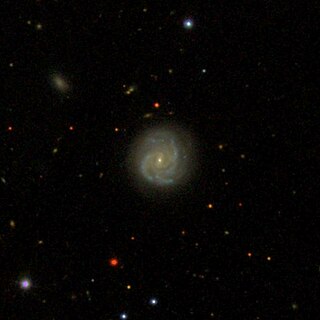
NGC 3009 is a lenticular galaxy in the constellation of Ursa Major. It is about 35 thousand light years across, and with a recessional velocity of 4,445 kilometers per second, is at a distance of 205 million light years from the sun. NGC 3009 is also known by the catalog name of PGC 28330, and is often mistaken for the dimmer PGC 28303. This is due to the fact that these objects are very close to each other in the sky, and the astronomer Dreyer misinterpreted John Herschel's original March 17, 1828 record of the galaxy, mistaking it for one a few arcminutes to the west. Herschel would have been unable to see PGC 28303 as anything but a background star, due to his less advanced telescope at the time.













